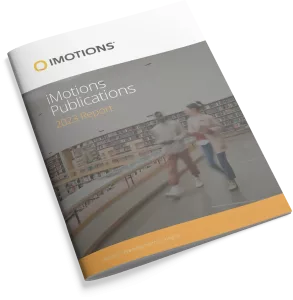-
Towards a conceptual framework for analysing impression management during face-to-face communication
Abstract: The purpose of this paper is to generate a framework for investigating direct face-to-face interactions during corporate results presentations from senior executives. This is important because face-to-face communications represent opportunities for impression management owing to cognitive biases and constraints arising from the interplay of non-verbal and verbal cues. Our Behavioural Impression Management Framework combines […] -
A Comparison of the Affectiva iMotions Facial Expression Analysis Software With EMG for Identifying Facial Expressions of Emotion
Human faces express emotions, informing others about their affective states. In order to measure expressions of emotion, facial Electromyography (EMG) has widely been used, requiring electrodes and technical equipment. More recently, emotion recognition software has been developed that detects emotions from video recordings of human faces. However, its validity and comparability to EMG measures is […] -
Comparing the Affectiva iMotions Facial Expression Analysis Software with EMG
Abstract: People’s faces display emotions, informing others about their affective states. In order to measure facial displays of emotion, Electromyography (EMG) has widely been used, requiring electrodes and technical equipment. More recently, emotion recognition software has been developed that detects emotions from videos. However, its validity and comparability to EMG is unclear. The aim of […] -
Eye gaze and facial displays of emotion during emotional film clips in remitted patients with bipolar disorder
Aberrant emotional reactivity is a putative endophenotype for bipolar disorder (BD), but the findings of behavioral studies are often negative due to suboptimal sensitivity of the employed paradigms. This study aimed to investigate whether visual gaze patterns and facial displays of emotion during emotional film clips can reveal subtle behavioral abnormalities in remitted BD patients. Thirty-eight […] -
A Visual Attentive Model for Discovering Patterns in Eye-Tracking Data-A Proposal in Cultural Heritage
In the Cultural Heritage (CH) context, art galleries and museums employ technology devices to enhance and personalise the museum visit experience. However, the most challenging aspect is to determine what the visitor is interested in. In this work, a novel Visual Attentive Model (VAM) has been proposed that is learned from eye tracking data. In […] -
Mobile and stationary eye tracking comparison – package design and in-store results
Abstract: Purpose This paper aims to test the similarity of the results of on-screen eye tracking compared to mobile eye tracking in the context of first fixation location on stimuli. Design/methodology/approach Three studies were conducted altogether with 117 participants, where the authors compared both methods: stationary eye tracking and mobile eye tracking. Findings The studies […] -
Affect and exertion during incremental physical exercise: Examining changes using automated facial action analysis and experiential self-report
Abstract: Recent research indicates that affective responses during exercise are an important determinant of future exercise and physical activity. Thus far these responses have been measured with standardized self-report scales, but this study used biometric software for automated facial action analysis to analyze the changes that occur during physical exercise. A sample of 132 young, […] -
Willingness to Pay for Rose Attributes: Helping Provide Consumer Orientation to Breeding Programs
Abstract: Floriculture value exceeds $5.8 billion in the United States. Environmental challenges, market trends, and diseases complicate breeding priorities. To inform breeders’ and geneticists’ research efforts, we set out to gather consumers’ preferences in the form of willingness to pay (WTP) for different rose attributes in a discrete choice experiment. The responses are modeled in […] -
Validating Physiological Stress Detection Model Using Cortisol as Stress Bio Marker
Abstract: In this work, we have presented the validation of a stress detection model using cortisol as the stress biomarker. The proposed model uses two physiological signals: Galvanic Skin Response (GSR) and Photoplethysmograph (PPG) to classify stress into two levels. GSR and PPG signals were collected from a total of 13 participants along with saliva […] -
The Use of Eye Tracking Technology in Aesthetic Surgery: Analyzing Changes in Facial Attention Following Surgery
The ability to quantitatively analyze how we look at a face and determine if this changes following facial surgery should be of interest to the plastic surgeon. Eye tracking technology (ETT) provides the ability to record where observers fixate when viewing a facial image, enabling quantitative data to be obtained comparing pre- and postoperative changes. […]
Research Report 2024
In-depth look at the scientific landscape as powered by iMotions software, showcasing groundbreaking research and the impact of our tools in various scientific and industrial fields.

iMotions Science Resources
Looking for white papers, validation reports or research show casing iMotions Multimodal capabilities?
Share Your Research

850+ universities worldwide with an iMotions human behavior lab
73 of the top 100 highest ranked universities
710+ published research papers using iMotions
iMotions is used for some of the most interesting human behavior research studies carried out by top researchers around the world. Contact us to have your publication featured here.
The authors of these publications have used iMotions as a software tool within their research.
“Software should be cited on the same basis as any other research product such as a paper or a book; that is, authors should cite the appropriate set of software products just as they cite the appropriate set of papers” (Katz et al., 2020).
We therefore encourage you to cite the use of iMotions where appropriate.
How to cite iMotions
APA
iMotions (10), iMotions A/S, Copenhagen, Denmark, (2024).
Note: adjust the version and year where relevant.
5 Most Popular Blogs
Publications
Read publications made possible with iMotions
Blog
Get inspired and learn more from our expert content writers
Newsletter
A monthly close up of latest product and research news


